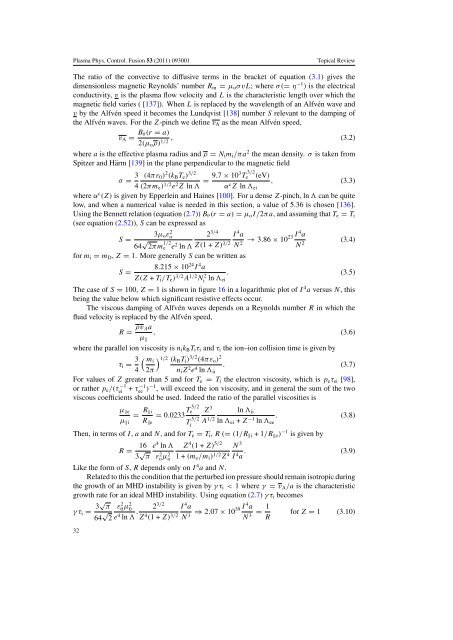Create successful ePaper yourself
Turn your PDF publications into a flip-book with our unique Google optimized e-Paper software.
Plasma Phys. Control. Fusion 53 (2011) 093001<br />
Topical Review<br />
The ratio <strong>of</strong> <strong>the</strong> convective to diffusive terms in <strong>the</strong> bracket <strong>of</strong> equation (3.1) gives <strong>the</strong><br />
dimensionless magnetic Reynolds’ number R m = µ o σvL; where σ(= η −1 ) is <strong>the</strong> electrical<br />
conductivity, v is <strong>the</strong> plasma flow velocity and L is <strong>the</strong> characteristic length over which <strong>the</strong><br />
magnetic field varies ( [137]). When L is replaced by <strong>the</strong> wavelength <strong>of</strong> an Alfvén wave and<br />
v by <strong>the</strong> Alfvén speed it becomes <strong>the</strong> Lundqvist [138] number S relevant to <strong>the</strong> damping <strong>of</strong><br />
<strong>the</strong> Alfvén waves. For <strong>the</strong> Z-<strong>pinch</strong> we define v A as <strong>the</strong> mean Alfvén speed,<br />
v A = B θ(r = a)<br />
, (3.2)<br />
2(µ o ρ)<br />
1/2<br />
where a is <strong>the</strong> effective plasma radius and ρ = N i m i /πa 2 <strong>the</strong> mean density. σ is taken from<br />
Spitzer and Härm [139] in <strong>the</strong> plane perpendicular to <strong>the</strong> magnetic field<br />
σ = 3 (4πε 0 ) 2 (k B T e ) 3/2<br />
4 (2πm e ) 1/2 e 2 Z ln = 9.7 × 103 Te<br />
3/2 (eV)<br />
, (3.3)<br />
α c Z ln ei<br />
where α c (Z) is given by Epperlein and Haines [100]. For a <strong>dense</strong> Z-<strong>pinch</strong>, ln can be quite<br />
low, and when a numerical value is needed in this section, a value <strong>of</strong> 5.36 is chosen [136].<br />
Using <strong>the</strong> Bennett relation (equation (2.7)) B θ (r = a) = µ o I/2πa, and assuming that T e = T i<br />
(see equation (2.52)), S can be expressed as<br />
3µ o εo<br />
2 S =<br />
64 √ 2 3/4 I 4 a<br />
2πme<br />
1/2 e 2 ln Z(1+Z) 3/2 N → 3.86 × I 4 a<br />
2 1023 (3.4)<br />
N 2<br />
for m i = m D , Z = 1. More generally S can be written as<br />
8.215 × 10 24 I 4 a<br />
S =<br />
Z(Z + T i /T e ) 3/2 A 1/2 Ni 2 . (3.5)<br />
ln ei<br />
The case <strong>of</strong> S = 100, Z = 1 is shown in figure 16 in a logarithmic plot <strong>of</strong> I 4 a versus N, this<br />
being <strong>the</strong> value below which significant resistive effects occur.<br />
The viscous damping <strong>of</strong> Alfvén waves depends on a Reynolds number R in which <strong>the</strong><br />
fluid velocity is replaced by <strong>the</strong> Alfvén speed,<br />
R = ρv Aa<br />
, (3.6)<br />
µ ‖<br />
where <strong>the</strong> parallel ion viscosity is n i k B T i τ i and τ i <strong>the</strong> ion–ion collision time is given by<br />
τ i = 3 ( mi<br />
) 1/2 (k B T i ) 3/2 (4πε o ) 2<br />
. (3.7)<br />
4 2π n i Z 2 e 4 ln ii<br />
For values <strong>of</strong> Z greater than 5 and for T e = T i <strong>the</strong> electron viscosity, which is p e τ ei [98],<br />
or ra<strong>the</strong>r p e /(τ −1<br />
ei<br />
+ τee −1)−1<br />
, will exceed <strong>the</strong> ion viscosity, and in general <strong>the</strong> sum <strong>of</strong> <strong>the</strong> two<br />
viscous coefficients should be used. Indeed <strong>the</strong> ratio <strong>of</strong> <strong>the</strong> parallel viscosities is<br />
µ ‖e<br />
µ ‖i<br />
= R ‖i<br />
= 0.0233 T e<br />
5/2<br />
R ‖e<br />
T 5/2<br />
i<br />
Z 3<br />
A 1/2<br />
ln ii<br />
ln ei + Z −1 ln ee<br />
. (3.8)<br />
Then, in terms <strong>of</strong> I, a and N, and for T e = T i , R (= (1/R ‖i +1/R ‖e ) −1 is given by<br />
R = 16<br />
3 √ e 4 ln Z 4 (1+Z) 5/2 N 3<br />
π εo 2µ2 o 1+(m e /m i ) 1/2 Z 4 I 4 a . (3.9)<br />
Like <strong>the</strong> form <strong>of</strong> S, R depends only on I 4 a and N.<br />
Related to this <strong>the</strong> condition that <strong>the</strong> perturbed ion pressure should remain isotropic during<br />
<strong>the</strong> growth <strong>of</strong> an MHD instability is given by γτ i < 1 where γ = v A /a is <strong>the</strong> characteristic<br />
growth rate for an ideal MHD instability. Using equation (2.7) γτ i becomes<br />
γτ i = 3√ π<br />
64 √ 2<br />
32<br />
ε 2 0 µ2 0<br />
e 4 ln . 2 3/2 I 4 a<br />
Z 4 (1+Z) 3/2 N 3<br />
⇒ 2.07 × 1039 I 4 a<br />
N 3<br />
= 1 R<br />
for Z = 1 (3.10)














